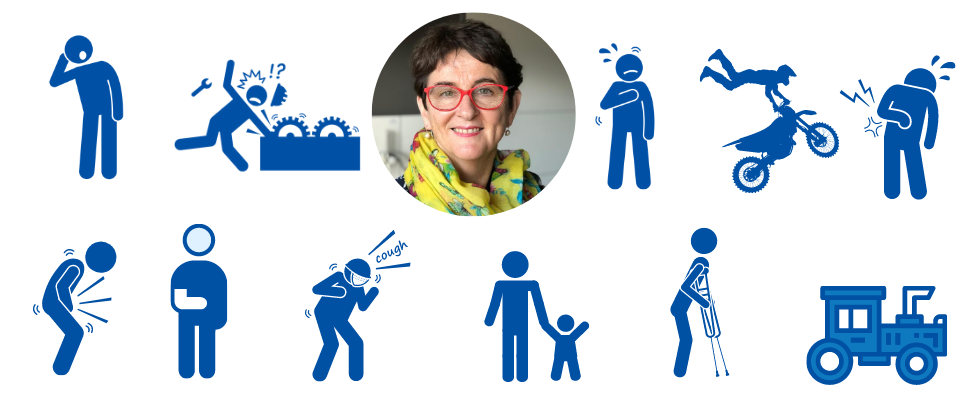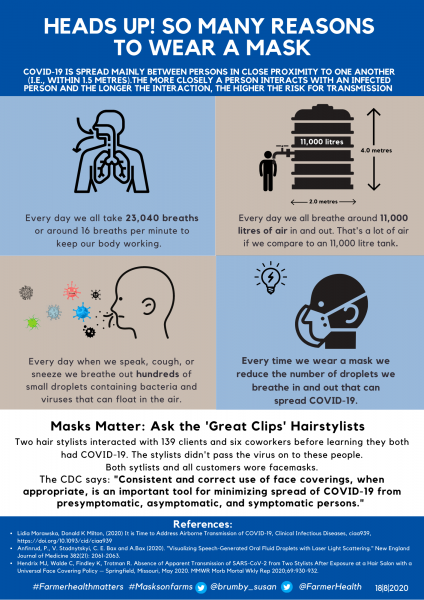
A recent paper indicated that whilst handwashing and social distancing are appropriate, they are insufficient to provide protection from virus-carrying respiratory micro droplets released into the air by infected people.(1)
From midnight on August 2, regional Victorians were required to wear face masks—including farmers. For many farmers, home is also their workplace and therefore must wear a mask if they have staff coming and going from the farm property. When you live and work in a family environment that is important because if you pick up COVID-19 from someone visiting the farm, you are very likely to take it into your home and infect your family. Even if visitors or staff feel well the viral load peaks in the day before symptoms of COVID-19 begin and just speaking is enough to expel virus-carrying droplets that can infect you, your family and staff.(2)
It’s pretty easy to understand why wearing a mask helps provide protection if you do the maths. An average person takes 23040 breaths per day, breathing in around 11000 litres of air. Think of an 11000 litre water tank. With each breath we inhale and exhale hundreds of biological particles, which include pollen, animal and human dander, plant debris, bacteria, and viruses. The smallest of these are viruses of up to 0.1 micron in size which is 200 times finer than your 20 micron wool. A recent experiment using high-speed video found hundreds of droplets were generated when saying a simple phrase, but that nearly all these droplets were blocked when the mouth was covered.(3)
This simple demonstration by Rich Davis, a Clinical Microbiology Lab Director(4) shows the effect of wearing a mask and not wearing a mask on bacterial spread (not viral spread) when sneezing, talking and coughing. He did this using bacterial culture plates.
Figure 1: Effect of wearing a mask and not wearing a mask on bacterial spread

According to Mr Davis ‘It is likely that smaller aerosolized droplets ( that could carry viruses like COVID-19) are also produced during coughing and sneezing and that these would travel further and stay in the air longer than larger droplets’. Masks can help stop someone who has an infection -and doesn’t know it – from passing it on and can also help prevent you getting sick.
For those Australians (not in Victoria) the World Health Organisation is now recommending face masks to prevent the spread of COVID-19(5) and as outbreaks and second and third waves occur being prepared. Our experience in Victoria is that when you need them (masks) you need them and having ready made or stocks of disposable masks on hand is a good idea. Stores ran out of masks for sale and elastic for mask making had length limits in place. As farms are getting into their busy season- lamb marking, calving, silage making, shearing, harvesting, mango season and selling stock- it is important that we don’t see a rise in COVID- 19 resulting in further lockdowns.
Wearing a mask can do more than just filter air, it can also help with social distancing through how we perceive others and how willing we are to get to close to strangers.(6) It is also great to see the VFF promoting #Masksonfarms on twitter – do check it out.
Remember: Wearing a clean mask every time you leave your house makes good sense. There are lots of mask patterns available online but make sure they cover both your nose and mouth and have 3 layers.(7)

References:
- Lidia Morawska, Donald K Milton, (2020) It is Time to Address Airborne Transmission of COVID-19, Clinical Infectious Diseases, , ciaa939, https://doi.org/10.1093/cid/ciaa939
- Jayaweera, M., H. Perera, B. Gunawardana and J. Manatunge (2020). “Transmission of COVID-19 virus by droplets and aerosols: A critical review on the unresolved dichotomy.” Environmental research 188: 109819-109819.
- Anfinrud, P., V. Stadnytskyi, C. E. Bax and A. Bax (2020). “Visualizing Speech-Generated Oral Fluid Droplets with Laser Light Scattering.” New England Journal of Medicine 382(21): 2061-2063.
- Rich Davis, (2020) PhD https://twitter.com/richdavisphd/status/1276737371464060928
- WHO (2020, 5 June) Advice on the use of masks in the context of COVID-19: Interim guidance.
- Massimo Marchiori, (2020) COVID-19 and the Social Distancing Paradox: dangers and solutions. https://arxiv.org/pdf/2005.12446.pdf
- DHHS (2020) Key Points, Hygiene and physical distancing. DHHS Vic https://www.dhhs.vic.gov.au/staying-safe-covid-19
|
|